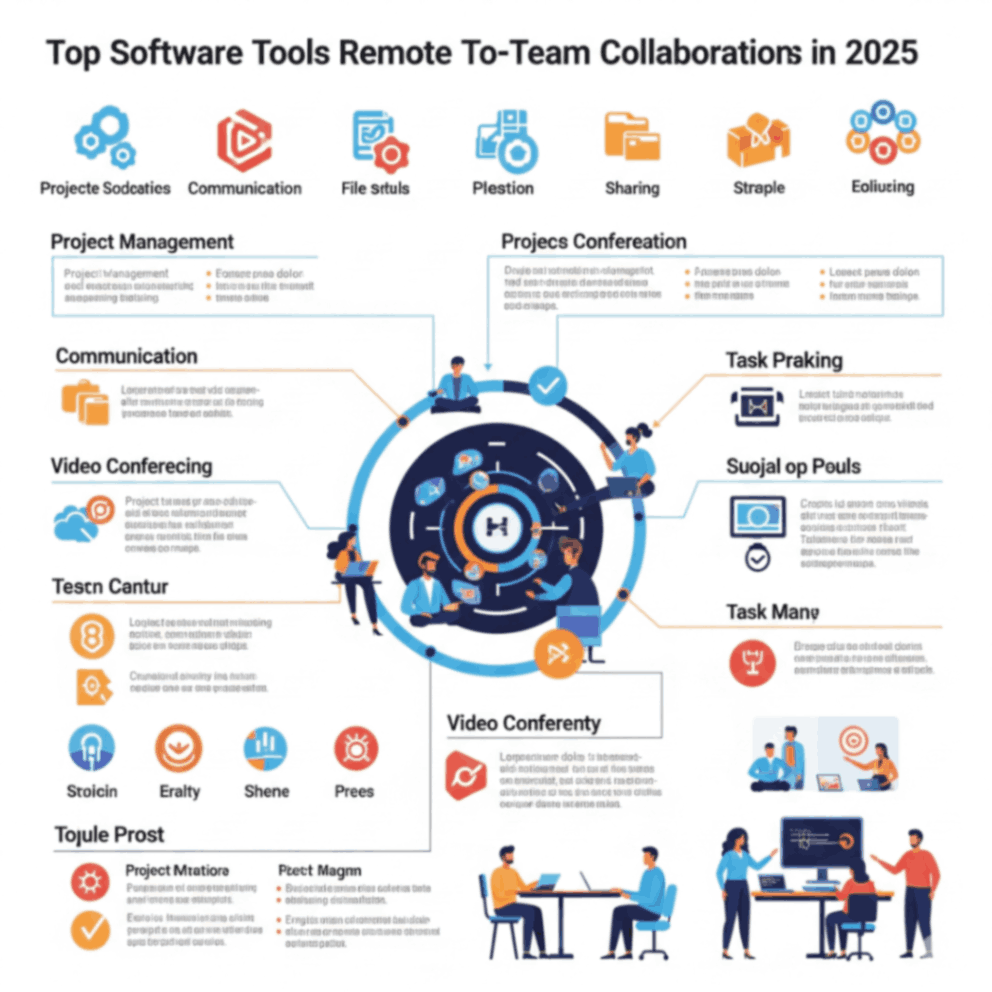Introduction
As the workforce continues to evolve, remote work is becoming a permanent fixture for many organizations. The rapid adoption of remote work models, accelerated by the COVID-19 pandemic, has changed the way teams communicate and collaborate. By 2025, remote collaboration tools will be more advanced and integrated into daily operations than ever before.
Effective collaboration among remote teams requires the right set of software tools to enhance communication, streamline workflows, and ensure project success. In this article, we’ll discuss the top software tools for remote team collaboration in 2025. These tools are designed to improve productivity, enhance communication, and foster teamwork, no matter where team members are located.
The Importance of Collaboration Tools for Remote Teams
For remote teams, collaboration software is not just a luxury but a necessity. Here’s why investing in the right tools is essential for remote team success:
-
Seamless Communication: Remote teams rely on clear and consistent communication to stay aligned on tasks and projects. Collaboration tools provide the infrastructure needed for smooth interaction.
-
Increased Productivity: With the right tools, teams can manage tasks, track progress, and automate routine processes, which helps reduce the time spent on manual work.
-
Centralized Workspaces: Collaboration tools allow teams to store files, share documents, and manage tasks in one centralized platform, reducing the chances of miscommunication and missed deadlines.
-
Flexibility and Accessibility: Remote work demands that employees can access information from any location. Cloud-based collaboration tools make this possible, ensuring everyone stays connected.
Top Software Tools for Remote Team Collaboration in 2025
Here are some of the best software tools available in 2025 for enhancing collaboration in remote teams. These tools will help streamline communication, improve efficiency, and allow your team to stay connected and productive.
1. Slack – Real-Time Messaging and Collaboration
Slack is one of the most popular communication platforms for remote teams. It enables real-time messaging, file sharing, and team collaboration within an organized workspace.
Key Features:
-
Channels: Create different channels for various teams, projects, or topics to keep communication organized.
-
Direct Messages: Communicate privately with team members when needed.
-
Integrations: Integrates with hundreds of apps such as Google Drive, Asana, and Zoom to streamline workflows.
| Feature | Benefit |
|---|---|
| Channels | Organize team communication into specific topics. |
| Direct Messaging | Quickly communicate with individuals privately. |
| App Integrations | Connect with other tools to enhance productivity. |
Why Use Slack:
-
Real-time communication increases productivity by allowing immediate feedback and collaboration.
-
Easily integrate with other project management tools to streamline workflows.
2. Asana – Project Management and Task Tracking
Asana is an excellent project management tool designed to help teams track tasks, projects, and deadlines. It’s ideal for remote teams that need to stay on top of projects without being in the same physical location.
Key Features:
-
Task Assignment: Assign tasks to specific team members with clear deadlines and priorities.
-
Project Timeline: Visualize project timelines and milestones to ensure everyone stays on track.
-
Collaboration: Allow team members to comment on tasks and share updates, ensuring continuous communication.
| Feature | Benefit |
|---|---|
| Task Assignment | Assign tasks and set clear deadlines for each team member. |
| Project Timeline | Visualize project progress and deadlines. |
| Collaboration | Allow team members to provide feedback and share updates. |
Why Use Asana:
-
Keep your team aligned on goals, tasks, and deadlines with real-time tracking.
-
It’s a central hub for project planning, communication, and execution, which improves accountability and efficiency.
3. Trello – Visual Task Management
Trello is a visual collaboration tool used to organize tasks and workflows. It utilizes a card and board system, making it easy to track progress and share updates across remote teams.
Key Features:
-
Boards and Lists: Create boards for different projects, and organize tasks within lists.
-
Drag-and-Drop Functionality: Easily move tasks between different stages of completion.
-
Power-Ups: Integrate with other tools, such as Google Drive, Slack, and Jira, to enhance functionality.
| Feature | Benefit |
|---|---|
| Boards and Lists | Organize projects and tasks in a clear, visual format. |
| Drag-and-Drop Functionality | Easily manage tasks and track progress. |
| Power-Ups | Integrate with other tools for extended functionality. |
Why Use Trello:
-
Its intuitive, visual interface is perfect for remote teams who need to stay organized and track task progress.
-
Great for small teams or projects that require simple yet effective task management.
4. Zoom – Video Conferencing and Collaboration
Zoom has become the go-to video conferencing tool for remote teams. It offers a variety of features to facilitate virtual meetings, webinars, and team collaboration.
Key Features:
-
HD Video and Audio: High-quality video calls ensure clear communication.
-
Screen Sharing: Share your screen to collaborate on presentations, documents, or projects in real-time.
-
Breakout Rooms: Split participants into smaller groups for focused discussions or brainstorming sessions.
| Feature | Benefit |
|---|---|
| HD Video and Audio | Clear communication during virtual meetings. |
| Screen Sharing | Collaborate on projects by sharing your screen in real-time. |
| Breakout Rooms | Facilitate smaller group discussions for better engagement. |
-
Zoom is the leading video conferencing platform for teams, allowing seamless meetings and collaboration, regardless of team size or location.
-
It’s perfect for remote team meetings, presentations, and collaborative discussions.
5. Microsoft Teams – Integrated Collaboration Hub
Microsoft Teams is an all-in-one collaboration platform that integrates with Microsoft 365 tools. It is ideal for teams that already use Microsoft products and want a centralized platform for communication and collaboration.
Key Features:
-
Real-Time Messaging: Instant communication within teams and channels.
-
Document Collaboration: Integrate with Word, Excel, and PowerPoint for real-time document editing.
-
Task Management: Keep track of tasks, deadlines, and project status directly within the platform.
| Feature | Benefit |
|---|---|
| Real-Time Messaging | Instant communication for team collaboration. |
| Document Collaboration | Edit documents in real-time with team members. |
| Task Management | Integrate with project management tools to stay organized. |
Why Use Microsoft Teams:
-
It’s perfect for businesses already embedded in the Microsoft ecosystem and seeking integrated team collaboration.
-
Teams allows for seamless communication, document sharing, and task management all within a single platform.
6. Miro – Online Whiteboard for Brainstorming and Collaboration
Miro is a digital whiteboard that enables teams to brainstorm, plan, and collaborate visually. It’s especially useful for remote teams looking for interactive ways to engage in creative or strategic sessions.
Key Features:
-
Infinite Canvas: Provides a flexible, limitless space for ideas and visual collaboration.
-
Pre-Built Templates: Access a variety of templates for planning, brainstorming, and project management.
-
Real-Time Collaboration: Multiple team members can contribute and interact on the whiteboard simultaneously.
| Feature | Benefit |
|---|---|
| Infinite Canvas | Collaborate visually with endless space for ideas. |
| Pre-Built Templates | Use templates to streamline brainstorming and planning. |
| Real-Time Collaboration | Multiple team members can interact in real-time. |
-
Miro is perfect for creative brainstorming sessions, project planning, and team discussions, all conducted in a visual and interactive environment.
-
It fosters collaboration and creativity among remote teams by offering real-time contributions.
How to Choose the Right Collaboration Tools for Your Remote Team
Selecting the right collaboration tools is crucial for remote teams to ensure productivity, communication, and efficiency. Here’s how you can choose the best tools for your business:
1. Consider Your Team’s Size and Needs
-
For small teams, lightweight tools like Trello and Slack may be sufficient. Larger teams or enterprises may require more robust solutions like Microsoft Teams or Zoom.
2. Assess Tool Integrations
-
Ensure the tools you choose integrate seamlessly with the existing software your team uses, such as project management systems, CRMs, or communication platforms.
3. Evaluate User Experience
-
The tool should be user-friendly and accessible to all team members, regardless of their technical expertise.
4. Focus on Security
-
Make sure the tools you choose provide robust security features, such as end-to-end encryption and multi-factor authentication.
FAQs
1. What are the best tools for remote team collaboration?
The best tools for remote team collaboration include Slack, Zoom, Microsoft Teams, Trello, Asana, and Miro. These tools provide solutions for communication, project management, document sharing, and brainstorming.
2. How do I improve collaboration in a remote team?
Improving collaboration in a remote team can be achieved by selecting the right collaboration tools, fostering clear communication, setting expectations, and encouraging regular check-ins.
3. Can I use free tools for remote collaboration?
Yes, many collaboration tools offer free versions, such as Slack, Trello, and Google Workspace, which are perfect for small teams or businesses just starting with remote work.
4. How do remote teams handle communication and meetings?
Remote teams typically handle communication through platforms like Zoom or Microsoft Teams for meetings and use Slack or Google Meet for day-to-day communication.
Conclusion
The rise of remote work has made effective team collaboration more critical than ever. The right software tools can help streamline workflows, improve communication, and increase productivity. As we move into 2025, investing in the right set of collaboration tools will ensure your remote team stays connected, organized, and efficient.
From project management tools like Asana to real-time communication platforms like Slack, there is a wealth of options available to suit the unique needs of your team. By selecting the right tools, you can enhance collaboration, drive results, and foster a more connected, productive workforce.
To learn more about remote team collaboration and the best tools for your business, visit Derektime for expert insights and resources


